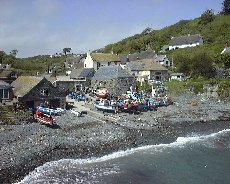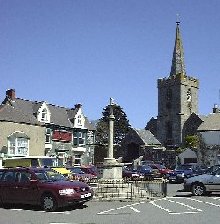
Cadgwith and St Keverne.
Part of the fun of exploring The Lizard is visiting the smaller and out of the way places.
|
Cadgwith. This must be one of Cornwall's loveliest villages. Is is crammed with cottages made from rough lumps of serpentine and roofed with thatch. Roofs covered in thatch are relatively rare in Cornwall as slate has been in use for many years. The naturally protected cove is still home to a small fleet of crabbing boats which are winched up the shingle beach. When the winter storms rage, it can be quite a sight to see the locals pushing the boats up the steep roads to the safety of the car park. Just to the south along the coastal path is the awesome Devil's Frying Pan. This is a 200' deep hole in the cliffs formed many years ago by the collapse of a sea cave. Part of the adventure of visiting Cadgwith is navigating the steep and narrow lanes into the village. |
|
|
The parish of St Keverne on the eastern side of the Lizard lies within an ancient area known as the "Meneage". This name is from the Cornish for "monkish land" and is believed to be a reference to the presence of several Celtic monasteries before the conquest. Is is known for certain that a least one of these monasteries was at St Keverne. The village has a pretty square with two good pubs. The large Church has a tall spire which can be seen miles out to sea and has been used as a navigation aid for centuries by mariners. In the St Keverne Churchyard there is a mass grave which holds most of the 106 people drowned when the SS Mohegan steamed into the Manacle Rocks in 1898 and this is only one of the many graves to those who met a similar fate. Following the signs out of the village can bring you to the fishing villages of Porthoustock and Porthallow |
Whether the weather is fair or foul, the Lizard is worth a visit.

